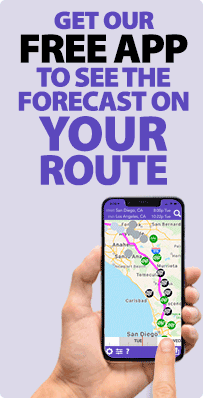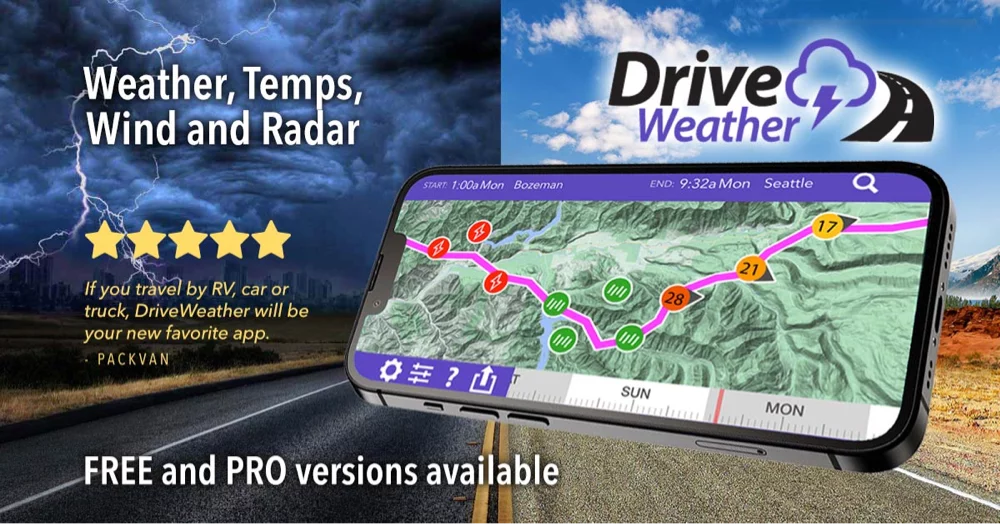Interstate 40 (I-40) Road Conditions
I-40 Road Conditions for December 18, 2025
Overall I-40 summary (state-issued details found): California (San Bernardino County) has multiple daytime work-zone impacts on I-40, including several off-ramp closures for paving, mainline lane/shoulder closures for paving, slab replacement, and roadway excavation, plus temporary closures of the John Wilkie Rest Area (eastbound and westbound) later today.
- Ramp closures (CA): Off-ramps to Hidden Springs Rd (Newberry Springs/Daggett), A St (Daggett), Nebo St (Daggett), S Iwo Jima Ave (Barstow), and River Rd (Needles) are scheduled closed during daytime work windows today.
- Mainline restrictions (CA): Daytime lane/shoulder closures are scheduled between locations including National Trails Hwy ↔ Montara Rd (Newberry Springs/Barstow area), D Street ↔ Park Rd (Needles area), and Main St ↔ Hector Rd (Barstow area).
- Facilities (CA): John Wilkie Rest Area (eastbound and westbound) near Fenner is scheduled closed late afternoon/evening today.
I-40 California Road Conditions
Relevant pages: Caltrans Planned Lane Closures (District 8) | Caltrans QuickMap
Ramp closures (Off-ramps)
- Eastbound off-ramp to Hidden Springs Rd (Newberry Springs) — closed 6:01:14 AM–6:01:14 PM; work: paving operation.
- Eastbound off-ramp to A St (Daggett) — closed 6:01:22 AM–6:01:22 PM; work: paving operation.
- Eastbound off-ramp to Nebo St (Daggett) — closed 6:01:31 AM–6:01:31 PM; work: paving operation.
- Eastbound off-ramp to S Iwo Jima Ave (Barstow) — closed 6:01:41 AM–6:01:41 PM; work: paving operation.
- Westbound off-ramp to S Iwo Jima Ave (Barstow) — closed 6:01:12 AM–6:01:12 PM; work: paving operation.
- Westbound off-ramp to Nebo St (Daggett) — closed 6:01:17 AM–6:01:17 PM; work: paving operation.
- Westbound off-ramp to A St (Daggett) — closed 6:01:23 AM–6:01:23 PM; work: paving operation.
- Westbound off-ramp to Hidden Springs Rd (Daggett) — closed 6:01:30 AM–6:01:30 PM; work: paving operation.
- Westbound off-ramp to River Rd (Needles) — closed 8:01:00 AM–3:59:00 PM; work: slab replacement.
Rest area / facility closures
- John Wilkie Rest Area – Eastbound (near Fenner) — closed 4:45 PM–11:59 PM; work: emergency work.
- John Wilkie Rest Area – Westbound (near Fenner) — closed 4:45 PM–11:59 PM; work: emergency work.
Road construction and lane restrictions (Mainline)
- Westbound mainline between D Street and Park Rd (Needles) — lane 1 closed 8:01:00 AM–3:59:00 PM; work: slab replacement (total lanes: 2).
- Westbound mainline between D Street and Park Rd (Needles) — lane 2 closed 8:01:00 AM–3:59:00 PM; work: slab replacement (total lanes: 2).
- Westbound mainline between Park Rd and D Street (Needles) — lane 1 closed 8:01:00 AM–3:59:00 PM; work: slab replacement (total lanes: 2).
- Westbound mainline between Park Moabi Rd and Agri Inspection Station (Topock) — right shoulder closed 7:01:46 AM–4:01:46 PM; work: shoulder work (total lanes: 2).
- Eastbound mainline between National Trails Hwy and Montara Rd (Newberry Springs) — lane 1 closed 6:01:48 AM–6:01:48 PM; work: paving operation (total lanes: 2).
- Eastbound mainline between Montara Rd and National Trails Hwy (Barstow) — lane 1 closed 6:01:04 AM–6:01:04 PM; work: paving operation (total lanes: 2).
- Eastbound mainline between Montara Rd and National Trails Hwy (Barstow) — lane 2 closed 6:01:13 AM–6:01:13 PM; work: paving operation (total lanes: 2).
- Eastbound mainline between Main St and Hector Rd (Barstow) — right shoulder closed 7:01:54 AM–5:01:54 PM; work: roadway excavation (total lanes: 2).
I-40 Road Conditions Overview
I-40 passing through northern Arizona near Flagstaff (high elevation region). Interstate 40 (I-40) is a major east–west highway spanning eight states from California to North Carolina, covering about 2,556 miles. As one of America’s longest interstates, I-40 connects the Pacific and Atlantic via deserts, mountains, plains, and major cities.
Interstate 40 spans over 2,500 miles across eight states from California to North Carolina. Road and weather conditions vary greatly along the route — from desert heat to mountain snow.
Regional Weather Hazards Along I-40
-
California & Western Arizona: Summer brings extreme heat (over 110°F) and dust storms. Winters are mild in the lowlands, but Flagstaff gets heavy snow. Be ready for sudden monsoon storms in July–September.
-
Eastern Arizona & New Mexico: I-40 stays at high elevation (up to 7,300 ft). Expect winter snow, strong crosswinds, and freezing nights. Summer days are warm, with thunderstorms possible.
-
Texas Panhandle & Oklahoma: This area is known for tornadoes in spring, ice storms in winter, and high winds year-round. Roads are flat but can get slick quickly.
-
Arkansas & Tennessee: Hot, humid summers with daily storms. In winter, ice storms and black ice can hit bridges and hills. Tornadoes are possible in spring.
-
Eastern TN & Western NC: The Appalachians bring steep grades, snow, fog, and rockslides. Conditions change fast — especially near Asheville and the Pigeon River Gorge.
-
Eastern NC (Raleigh to Wilmington): Summer storms and hurricanes can flood roads. Winters are mild but ice storms can occur every few years.
✔ Always check local forecasts and be ready for snow, fog, wind, or flooding along your route.
Current Road Conditions & Work Zones on I-40
Road conditions along I-40 can shift dramatically across its 2,500+ mile route due to aging infrastructure, ongoing maintenance, and regional weather damage. While some stretches offer smooth travel, others are rough or under construction. Here’s what to expect:
🛣️ Desert & Southwest (CA to NM)
-
Western I-40, especially in California and Arizona, often has worn pavement, heat cracks, and surface ruts, particularly between Barstow and Flagstaff.
-
Summer heat can degrade asphalt rapidly, and wind-blown sand may cause erosion or debris on the road.
-
Be alert for blowing dust advisories and single-lane closures for emergency repairs.
🚧 Urban Construction Zones
-
Cities like Oklahoma City, Little Rock, Memphis, Nashville, and Raleigh frequently have major construction projects, including:
-
Bridge repairs
-
Interchange expansions
-
Resurfacing projects
-
-
Expect nighttime lane closures, narrowed shoulders, and reduced speed limits.
-
In Oklahoma City, for example, a multi-month bridge rehab at I-44 causes major daytime slowdowns and overnight closures.
-
Always merge early and obey posted signs — fines double in work zones, and traffic can back up fast during peak hours.
⛰️ Mountain Pass & Rockslide Areas
-
In the Smoky Mountains (TN/NC border) and around Black Mountain, I-40 sees:
-
Rockslide repair projects
-
Lane reductions in tunnels and curves
-
Brake check pull-offs for trucks
-
-
Fog and wet pavement increase risks, especially on curvy downhill grades.
-
In Arizona and New Mexico, high-elevation roadwork can be delayed due to snow or high winds — always check before crossing mountain zones.
❄️ Seasonal Maintenance & Closures
-
Winter (Dec–Feb): Expect plowing, salting, and rolling closures during snow or ice storms, especially from Flagstaff to Albuquerque and through Tennessee and North Carolina.
-
Spring (Mar–May): Flood repair work is common in low-lying areas of eastern Oklahoma, Arkansas, and central NC.
-
Summer (May–Sep): Asphalt resurfacing, guardrail replacements, and bridge maintenance often cause daytime lane closures and slower speed zones.
-
Fall (Oct–Nov): Some repaving continues, but overall work decreases as colder weather sets in.
High-Risk Zones & Traffic Hazards
-
Albuquerque, OKC, Nashville, Memphis: These urban areas see heavy merging, frequent crashes, and construction delays.
-
Tennessee Stretch: I-40’s entire path across TN is one of the most dangerous, with steep grades and dense traffic from Memphis to Knoxville.
-
Smoky Mountains (TN/NC): Sharp curves, fog, and wildlife crossings increase accident risk. Drive slowly and cautiously.
-
Long Rural Stretches: Between Barstow, Gallup, and Amarillo, driver fatigue, dust storms, and lack of lighting can make night driving hazardous.
✔ Stay alert and avoid speeding. Know your location and plan breaks ahead.





